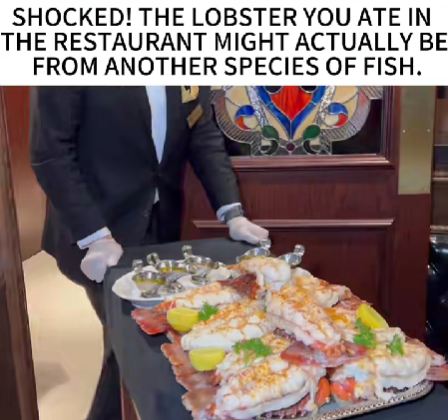If you recently treated yourself to a pricey lobster dinner, you might not have gotten what you paid for. According to a growing number of investigations, some restaurants may be serving imitation lobster made from other, cheaper species of fish — and customers are completely unaware.
Seafood lovers are stunned as food safety experts uncover a troubling trend: dishes labeled as “lobster” could actually be made from white fish like haddock, monkfish, or even pollock, cleverly seasoned and shaped to mimic the real thing.
“We’ve tested dozens of samples from restaurants across multiple cities,” said one food industry investigator. “A shocking percentage turned out not to be lobster at all.”
The deception works because many customers can’t tell the difference between authentic lobster meat and skillfully prepared imitation seafood — especially when it’s mixed into pasta, bisques, or sushi rolls.
The scam, sometimes called “seafood substitution,” allows dishonest suppliers or restaurants to make huge profits. Real lobster is one of the most expensive seafood items, costing up to ten times more than cheaper alternatives.
“It’s easy money for people willing to cheat,” said a former restaurant chef. “They buy imitation meat for a fraction of the price and most diners never suspect a thing.”
DNA testing conducted by consumer watchdog groups has revealed that over 40% of seafood sold in restaurants and markets is mislabeled — meaning what’s on your plate may not match what’s on the menu.
“You could be eating fish that was caught thousands of miles away, labeled as ‘fresh local lobster,’” said marine biologist Dr. Helen Cruz.
Beyond deception, there are potential health concerns. Some imitation seafood products contain preservatives, artificial coloring, or allergens not listed on menus. For individuals with shellfish allergies, the reverse can also be risky — mistakenly being served real lobster instead of imitation meat could lead to severe allergic reactions.
Restaurants caught in the act often claim ignorance, blaming their suppliers for the mix-up. But food safety agencies warn that the responsibility still lies with the establishment.
“Every restaurant should verify its supply chain,” said a spokesperson from a food standards agency. “Consumers have the right to know exactly what they’re eating.”
Social media has exploded with reactions as diners share stories of suspiciously cheap “lobster” meals. One user wrote,
“Now I’m wondering if that $10 lobster roll I had last weekend was even real…”
Meanwhile, honest chefs are urging customers not to panic — authentic lobster is still available in many trusted restaurants, especially those that display certification or show their suppliers transparently.
Experts recommend these quick tips to spot the difference:
- Texture: Real lobster meat is firm and fibrous, not mushy.
- Color: Authentic lobster tends to have a natural, uneven pink hue after cooking.
- Price: If it’s suspiciously cheap, it’s probably not real lobster.
So next time you order that buttery lobster tail or bisque, take a closer look — because what’s on your plate might not be from the ocean royalty you thought it was.
